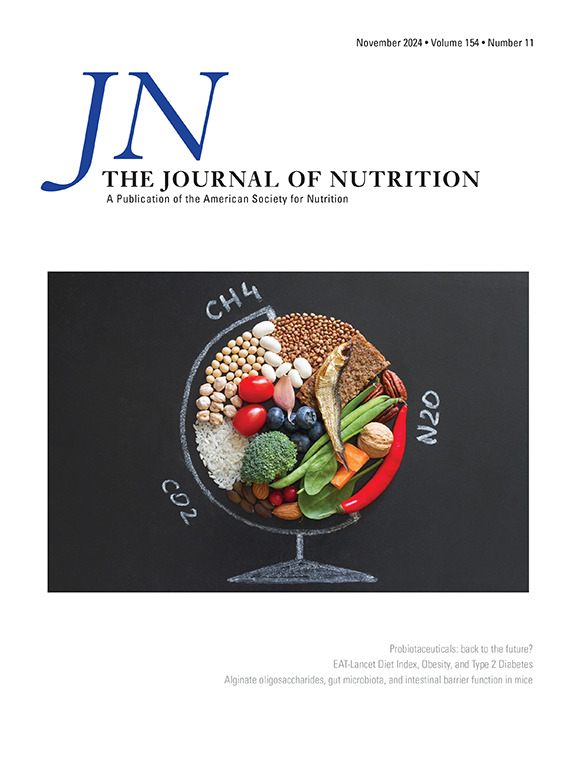在赞比亚三个地区试用小量脂质营养补充剂和家庭安装的生长图表后,2-3 岁儿童发育迟缓的预测因素和线性生长的路径分析。
IF 3.7
3区 医学
Q2 NUTRITION & DIETETICS
引用次数: 0
摘要
背景:全球有 1.48 亿 5 岁以下儿童发育迟缓,风险因素因环境而异。我们的 "赞比亚生长图表和营养补充剂对儿童生长的影响"(ZamCharts)试验观察到,在每月发放小量脂质营养补充剂(SQ-LNS)和/或在儿童家中安装壁挂式生长图表的干预措施实施 18 个月后,所有治疗组的发育迟缓率都居高不下:我们试图找出参与 ZamCharts 终端调查的 27-36 个月儿童(人数=1911)发育迟缓和身高-年龄 Z 值的决定因素:采用多层次对数二叉模型估算发育迟缓预测因素的单变量和多变量流行率。多层次模型还用于预测有基线身高-年龄 Z 值(HAZ)和无基线身高-年龄 Z 值(HAZ)(在 2-11 个月大时进行评估)的身高-年龄 Z 值(HAZ)。我们还利用线性结构方程的协方差分析进行了路径分析,以评估线性生长受损的潜在和可改变的风险因素:在多变量模型中,发育迟缓的重要预测因素包括:资产拥有率低;男性;使用生物质作为烹饪燃料;母亲身高较低;母亲的初等教育程度≤;基线 HAZ 较低,以及未随机接受 SQ-LNS 治疗。在完整的多变量模型中,平均 HAZ 值较低的重要预测因素包括所有与预测发育迟缓相同的风险因素,以及居住在城市地区、有一个以上孩子等:在赞比亚预防发育迟缓需要对生命早期(产前和产后)生长轨迹的决定因素进行投资,并改善辅食喂养方法和应对传染病的风险因素;SQ-LNS 也能改善线性生长和减少发育迟缓。本文章由计算机程序翻译,如有差异,请以英文原文为准。
Predictors of Stunting and Pathway Analysis for Linear Growth among Children Aged Two to Three Years after a Trial of Small-Quantity Lipid-Based Nutrient Supplements and Home-Installed Growth Charts in Three Districts in Zambia
Background
Globally, 148 million children aged <5 y are stunted, with risk factors varying by context. Our “Impact of Growth Charts and Nutritional Supplements on Child Growth in Zambia” (ZamCharts) trial observed persistently high rates of stunting in all treatment groups after 18-mo of intervention with monthly distributions of small-quantity lipid-based nutrient supplements (SQ-LNS) and/or installation of a wall-mounted growth chart in children’s homes.
Objectives
We sought to identify determinants of stunting and height-for-age z-score in children aged 27–36 mo who participated in the ZamCharts endline survey (n = 1911).
Methods
Multilevel, log-binomial models were used to estimate univariable and multivariable prevalence ratios for predictors of stunting. Multilevel models were also used to predict height-for-age z-score (HAZ) with and without baseline HAZ (assessed at ages 211 mo). We also conducted a path analysis using covariance analysis of linear structural equations to assess underlying and modifiable risk factors for impaired linear growth.
Results
Significant predictors of stunting in the multivariable model included low asset ownership, being male, using biomass as cooking fuel, lower maternal height, a mother with ≤ primary education, lower baseline HAZ, and not being randomly assigned to SQ-LNS. Significant predictors of a lower mean HAZ in the full multivariable models included all the same risk factors that predicted stunting but also living in an urban area, having ≥1 child aged <5 y in the household, and diarrhea in the previous 2 wk. The multivariable model explained 48% of variability in endline HAZ; the strongest predictor was baseline HAZ, which explained 29% of endline HAZ variability in the univariable model.
Conclusions
Preventing stunting in Zambia will require investments in early life (pre- and postnatal) determinants of growth trajectory as well as improving complementary feeding practices and addressing risk factors for infectious diseases; SQ-LNS can also improve linear growth and reduce stunting.
求助全文
通过发布文献求助,成功后即可免费获取论文全文。
去求助
来源期刊

Journal of Nutrition
医学-营养学
CiteScore
7.60
自引率
4.80%
发文量
260
审稿时长
39 days
期刊介绍:
The Journal of Nutrition (JN/J Nutr) publishes peer-reviewed original research papers covering all aspects of experimental nutrition in humans and other animal species; special articles such as reviews and biographies of prominent nutrition scientists; and issues, opinions, and commentaries on controversial issues in nutrition. Supplements are frequently published to provide extended discussion of topics of special interest.
 求助内容:
求助内容: 应助结果提醒方式:
应助结果提醒方式:


